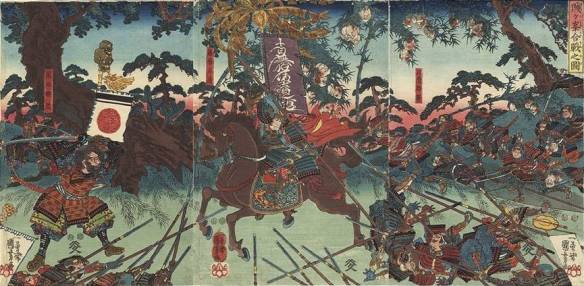Civil war erupted in the area around Kyoto during the tenure of the eighth shogun, Ashikaga Yoshimasa (1436–90; r. 1449–76). The Onin War (1467–77), bearing the name of the reign era when the conflict began, was brought about by economic decline, famine, and disputes over succession practices for both regional military governor (shugo) positions and the shogunate. General economic deterioration was pushed further than before by the final unraveling of the shoen system. Power no longer resided with agents of the shogunate, or obligations owed to the shogun; rather, authority depended upon steadfast vassals, securely held lands, fortifications such as castles, tactical acumen, and military skills.
Concerns over shogunal succession resulted from the fact that Yoshimasa had produced no heir to follow him as shogun. Yoshimasa decided that his younger brother should become the next shogun, but when that brother fathered a son, a power struggle ensued within the Ashikaga family. Ashikaga administrators and shugo also entered the dispute. The Onin War started in 1467 when the forces of Hosokawa Katsumoto fought with those of Yamana Sozen (or Mochitoyo). Hosokawa’s army was supported by both the emperor and the shogun. The Yamana army was assisted by the powerful Ouchi daimyo family. Fighting was concentrated in the Kyoto area and the capital was largely destroyed during the 10 years of the war. By the time hostilities ended in the capital in 1477, warfare had spread to the provinces, where it continued.
Opposition to the shogunate grew in the region around Kyoto, compounded by uprisings in the Kanto region and elsewhere. Revolts of significant scope began to occur on a nearly annual basis as the shogunate became less concerned with suppressing such disturbances. Regional lords long dependent upon bakufu clout to dissuade their most assertive vassals from rebelling could no longer assume that their domains were protected by loyalty. Irrefutable vassal command over provincial concerns amid Ashikaga weakness became more apparent after the sixth shogun, Ashikaga Yoshinori (1394–1441; r. 1429–41) was assassinated in 1441 by an affronted shugo. In circumstances even more threatening to the Ashikaga regime, certain daimyo and shugo had consolidated their power in domains that functioned effectively without need for a centralized government. In uncertain economic times, dramatic changes in land administration and ownership thus contributed to numerous circumstances that effected the breakdown of the Ashikaga shogunate.
The decisive collapse of Ashikaga authority in 1467 unleashed internecine struggles for land control previously deterred by vassal and daimyo obligations to the shogun. Regional lords, who became accustomed to shugo collecting rents, taxes, and even claims to land in domains they administrated, realized that the estates and revenues had passed out of owner control. The results could be financially and politically devastating for daimyo. In the 15th century, one court family reported that it was divested of 14 out of its 23 estates by local shugo and gokenin. Shugo succession, which had shifted from the shogunate to hereditary and local control, was a major factor in the formation of such powerful domains with complete disregard for official bakufu protocols.
Significant economic hardship persisted in Japan from the middle of the 15th century until the official end of the Muromachi shogunate in 1573. Scant Ashikaga assets had long been insufficient to cover expenditures, and the shogunate continued to neglect provincial and economic matters, ensuring its own demise. The burden of regular taxes imposed on farmers and merchants worsened as emergency measures taxed houses and rice fields. A famine in the mid-15th century and a series of weather-related catastrophes increased the spread of poverty.
Yoshimasa tried to ease economic strains by issuing debt cancellation edicts (tokuseirei) but this failed to alleviate the problem. Inadequate as a ruler, he compounded the problem by filling his time with cultural rather than political pursuits. Instead of addressing the significant problems of his day, he effectively retired from the world, cloistered in an elegant detached palace, the Temple of the Silver Pavilion (Ginkakuji) in Kyoto’s Higashiyama district. As a result of such inattention to affairs of state, Ashikaga power was eclipsed by Ashikaga administrators, most notably those from the Hosokawa family. Their retainers, the Miyoshi family, usurped the Hosokawa in the 16th century, and, finally, the Miyoshi were superseded by the Matsunaga family.
The countryside was in disarray and farming villages banded together to defend themselves. The leaders of these affiliated villages were local samurai who sometimes took advantage of the civil unrest to proclaim themselves the heads of domains. The most powerful of these domain lords even challenged the power and authority of the established shugo. Besides producing extensive civil unrest, the prolonged warfare resulted in a significant loss of income for both Kyoto aristocrats and Buddhist temples, whose income generated by outlying estates was interrupted. As a result many aristocrats fled Kyoto for the provinces, sometimes seeking security in the castle towns protected by local daimyo.
There was one benefit to the internecine struggles instituted by the Onin War. Tightly controlled daimyo and shugo domains actually fostered increases in economic production as these landholders were more likely to institute capital improvements that would increase production, such as irrigation, or advocating commerce to enhance laborer incomes.
Technically, the shogunate survived the war and its own weak political leadership, although vassals with great military skill and resources exerted real power. These vassals usually possessed land, and in the mid-15th century, began to construct fortress-like castles to defend their territories. Ultimately, these experienced, resourceful vassals challenged the shugo, often overthrowing the military governors and even annexing their domains. These powerful vassals came to be known as sengoku daimyo during the Muromachi era. Approximately 250 daimyo domains are estimated to have existed by the early 16th century.
